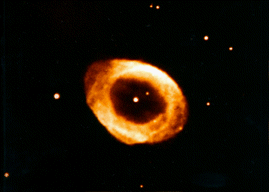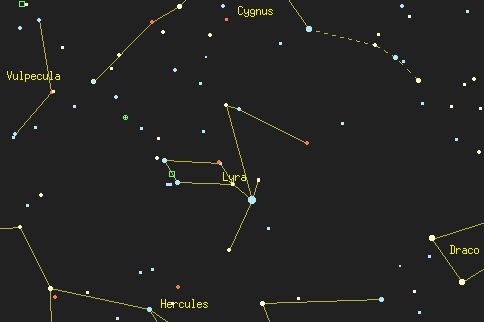LYRA

M57 Ring Nebula

A small but bright northern constellation lying between DECL=+30 and DECL=+40 and RA=18h and RA=19h. The fifth-brightest star of the sky, alpha Lyr, called Vega (arabic for "stone eagle"), radiates from the top Lyra with a pure white colour. Together with alpha Cyg, Deneb , and alpha Aql, Atair, Vega forms the Summer Triangle.
Stars and other objects
Beta Lyr is a half separated (i.e. one of the stars reached its Rochevolume) eclipsing binary of a cream-white colour. The brightness varies from 3.4 mag to 4.3 mag every twelve days and 22 hours. With larger telescopes beta Lyr is resolved as an attractive double star with an blue companion of 8th mag. Additionally two other 9th mag companions can be seen in small telescopes).
Another double variable is delta Lyr. With the help of binoculars you can view a blue-white star of 6th mag and a semi-regular red giant. The brightness of the latter varies erratically from 4th to 5th magnitude.
An easy object with binoculars or small telescopes is Zeta Lyr consisting of a 4th and a 6th mag star.
One of the most celebrated quadruple stars in the sky is epsilon Lyr. It is commonly known as the Double Double. In a very clear, moonless night it is possible to see the wide pair of 5th mag stars. Each star of this double is an double itself. But to resolve them a telescope with at least 60 mm aperture and a high magnification is needed.
The binary a 11871 requires telescopes with an aperture of at least 12cm for resolution. The two stars orbit each other with a period of 62 years.
The famous Ring Nebula, M 57, is perhaps somewhat disappointing when viewed through amateur telescopes but really terrific on long-exposure photographs. In small telescopes it presents itself on dark nights as a ghostly elliptical disk. Its apparent size is larger than that of Jupiter. To see the central hole a telescope of at least 150 mm aperture is needed. The central, very blue star is so faint that it is beyond the power of amateur telescopes to be revealed. The nebula can be found half way between beta Lyr and gamma Lyr.
Three meteor showers seem to radiate from this constellation: the Lyrids, the June Lyrids and the Alpha Lyrids. The latter two are active in the summer time. The Alpha Lyrids are visible from july, 9th, to july, 20th, and reach their maximum activity on the 14th of july. As the name suggests the June Lyrids can be observed in june, from the 10th to the 21st reaching the maximum on the 15th with an hourly rate of about 8 meteors. The Lyrids are typically visible from April, 16th, to April 25th, with its maximum around the 20th to 21st. Detailed information can be found in Gary Kronk's database about meteor showers.
Lyra is best seen in June through October in the Northern Hemisphere.
MYTHOLOGY

On older skymaps Lyra ist represented as a bird: Vultur, the Vulture. Together with the Cygnus, the Swan, and Aquila, the Eagle, it is hunted by Hercules.
Another story says that Mercury invented the lyre by placing strings across the back of a tortoise shell. So sometimes in early descriptions this constellation is also drawn as a tortoise.
Lyra the 'Lyre' or 'Harp' is the instrument invented by Hermes (Mercury) and given to Apollo his half-brother, who in turn gave it to his son Orpheus, the musician of the Argonauts, and son of Apollo and the muse Calliope. Apollo gave his son the lyre as a gift, and Orpheus played it so well that even the wild beasts, the rocks, and the trees were charmed by his music. He fell deeply in love with the nymph Eurydice, and the two were married.
Their wedded bliss did not last for very long, however. Eurydice was wandering in the fields with some other nymphs when she was seen by the shepherd Aristaeus. Aristaeus was struck by her beauty and pursued her; as she fled, she was bitten by a snake in the grass and died of the serpent's poison.
Orpheus was devastated. He decided to seek out his wife in the underworld, and gained an audience with Pluto and Persephone. The king and queen of the underworld, like all others, were charmed by his music and granted him permission to take Eurydice back to the land of the living with him:
They called Eurydice. She was among the ghosts who had but newly come, and walked slowly because of her injury. Thracian Orpheus received her, but on condition that he must not look back until he had emerged from the valleys of Avernus or else the gift he had been given would be taken from him.
Up the sloping path, through the mute silence they made their way, up the steep dark track, wrapped in impenetrable gloom, till they had almost reached the surface of the earth. Here, anxious in case his wife's strength be failing and eager to see her, the lover looked behind him, and straightaway Eurydice slipped back into the depths.
Orpheus stretched out his arms, straining to clasp her and be clasped; but the hapless man touched nothing but yielding air. Eurydice, dying now a second time, uttered no complaint against her husband.
What was there to complain of, that she had been loved? With a last farewell which scarcely reached his ears, she fell back again into the same place from which she had come
According to Ovid, Orpheus was so morose that he rejected the company of the Thracian women in favor of the company of small boys. The women were infuriated and, when maddened by the rites of Bacchus, hurled rocks at the bard. The rocks, tamed by the sound of the lyre, fell harmlessly at his feet until the screams of the infuriated women drowned out the music.
The women dismembered Orpheus, throwing his lyre and his head into the river Hebrus. The Muses gathered up his limbs and buried them, and Orpheus went to the underworld to spend eternity with Eurydice. Jupiter himself cast the bard's lyre into the sky.
Lyra may be easily be seen because of Vega, at zero magnitude the second brightest star in the northern sky. Vega is also part of the summer triangle, formed with Deneb and Altair.
In Latin Lyra as often the alpha star or lucida takes on the name of the constellation. Flamsteed's had Testa fulgida dicta Lyra; Latin Fidis and Fides "lyre", "string" and Fidicula.
Early Christians saw Lyra as King David's Harp.
In Holland's translation of Pliny it is the 'Harp-Star'.
No comments:
Post a Comment